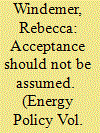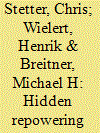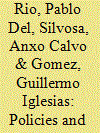| Srl | Item |
| 1 |
ID:
191170


|
|
|
|
|
| Summary/Abstract |
Local community acceptance is a key influence on wind farm siting decisions. However, there is a temporal limitation to much social acceptance literature in that it does not consider how perceptions of the local community may change over the operational life of a wind farm and in the context of end-of-life applications for repowering or life-extension. In response, this paper increases the temporal depth of our understanding of social acceptance through presenting the results of survey research undertaken with communities living close to two English wind farms that have experienced end-of-life applications. For many respondents, perceptions of their local wind farm did not change following construction or over the life of the scheme, contrasting with common expectations that acceptance will increase over time. The findings reveal that community support for applications to repower or life-extend is influenced by experiences of living with the wind farm over time. It also shows how factors that have been found to impact perceptions of new wind farms, particularly the benefits that people experience, involvement in the planning process, and relationships with the developer, can influence responses to end-of-life applications. These insights are used to provide recommendations for end-of-life policy.
|
|
|
|
|
|
|
|
|
|
|
|
|
|
|
|
| 2 |
ID:
186442


|
|
|
|
|
| Summary/Abstract |
Feed-in tariff funding will cease by 2025 for more than 70% of the currently installed onshore wind turbines in Germany. For many wind turbines, the feasibility of repowering from a regulatory point of view is unknown; that is, a complete replacement of the old wind turbines with new, modern, and more efficient models. In Germany, restrictive regulations regarding the required minimum distances of wind turbines from residential and other protected areas may impede repowering, thereby rendering a site non-repowerable. Many of these wind turbine sites are well-established in terms of their acceptance by the local population. Our analysis shows that the potential of non-repowerable but well-established locations with more efficient technology at the same height is almost twice that of the sites qualified for repowering via higher wind turbines. The latest legislation of the German federal government prescribes minimum distances of 1,000 m between a wind turbine and the nearest residential buildings. This will slow down the expansion of onshore wind energy in Germany and decrease its contribution to climate neutrality. This study quantifies the nationwide effects of restrictive legislative minimum distance regulations on repowering potential by means of a developed geographic information system that utilizes highly detailed settlement structures.
|
|
|
|
|
|
|
|
|
|
|
|
|
|
|
|
| 3 |
ID:
103325


|
|
|
|
|
| Publication |
2011.
|
| Summary/Abstract |
Repowering of a wind farm is the process of replacing existing wind turbines with new turbines that either have a larger nameplate capacity or more efficiency, resulting in a net increase of the power generated. Although repowering brings, both, social and private benefits, there are also several obstacles to repowering which justify public support. The aim of this paper is to provide an overview and a qualitative analysis of instruments and design options to support repowering of on-shore wind farms. The multicriteria analysis carried out in this paper shows that all instruments have their advantages and drawbacks. However, feed-in tariffs and investment subsidies seem to be particularly appropriate instruments in this regard. Furthermore, we provide an assessment of different design options to promote repowering according to key assessment criteria. The relevance of design elements hinges on the fact that these are the ones directly affecting the variables that are relevant in the decision to repower (capacity factors and investment costs).
|
|
|
|
|
|
|
|
|
|
|
|
|
|
|
|